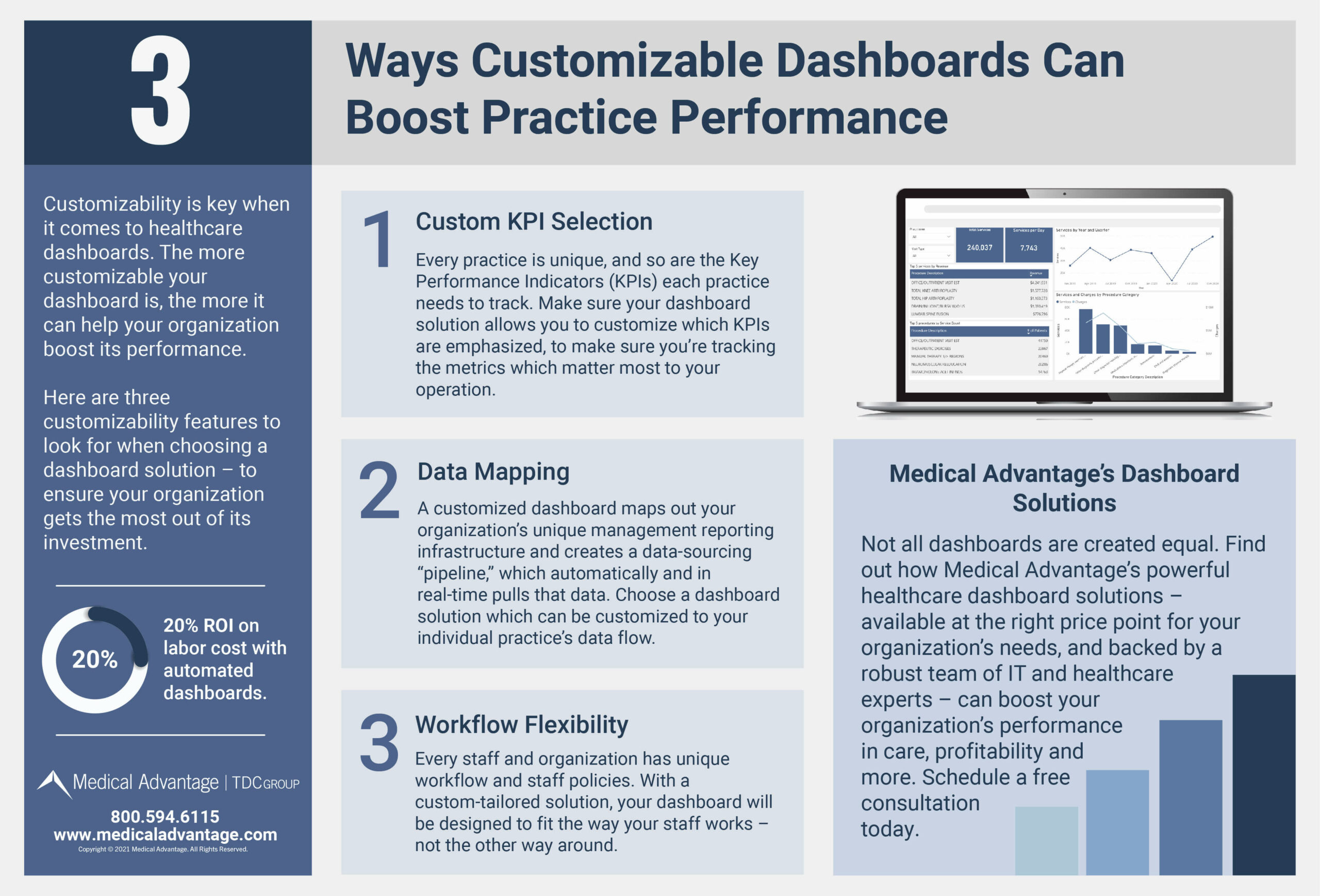Healthcare analytics dashboards are software tools which compile multiple, disparate datasets into one centralized view. The automated and intuitive view provided by healthcare dashboards allows medical, business, and administrative professionals to see – at a glance – how their organization is performing across a number of important revenue- and care-related KPIs (key performance indicators).
In other words, they easily help you to assess the “health” of your medical business.
Empowered with these insights into the organization’s performance, practice staff and leadership are equipped to make data-driven decisions about business and care strategy. The result? Healthcare dashboards help improve patient outcomes, bolster performance in payer contracts, boost appointment and staff utilization rates, reduce physician burnout, and enhance revenue across practice operations.
However, you need a customized solution – healthcare analytics dashboards are not one-size-fits-all. Customizing your healthcare dashboard solution to fit your practice’s workflows, needs, and tendencies is essential to getting the most out of your investment.
Learning more about how dashboards are utilized across healthcare is a great first step toward selecting the best program to enhance your own organization’s performance.
Dashboards in Healthcare – a New Healthcare Industry Standard
Even as healthcare has slowly but surely embraced the digital age, one area of operations has remained a pain point for many care providers: management reporting. Many healthcare professionals are familiar with the frustration of manually assembling data from scattered sources such as EHRs, financial reports, payer claims, patient registries, scheduling software, and more – and seeing that data report become outdated the moment it’s printed.
To the rescue, healthcare analytics dashboards are the ideal solution to these problems. For one, dashboards in healthcare automatically and continually pull information – in real-time, behind the scenes, and without manual data entry – to display it in one overview. This solves two problems with one solution: Providers no longer have to waste time collecting and assembling information, and they no longer have to deal with reports which are immediately out-of-date and obsolete. An up-front investment in designing relevant dashboards will continue to pay off.
Healthcare dashboards have been embraced by the healthcare industry for these reasons, but not all healthcare analytics dashboards are created equal. Taking care to avoid inflexible, non-customizable options is an important prerequisite to choosing the right dashboard solution for your medical organization.
Avoiding One-Size-Fits-All Healthcare Dashboards
Dashboards in healthcare are everywhere these days. With hundreds of companies offering healthcare dashboard solutions – all promising time-saving features and lucrative results – it can be overwhelming to sort through all the options. After all, healthcare professionals have their hands full with the day-to-day work of caring for their patient populations, and software isn’t a priority (nor should it be).
That is why customizability is one of the most important things to look for when selecting an approach to healthcare dashboards. Unfortunately, many vendors in healthcare do not offer much in the way of customization out of the box.
Here are some of the top tips and features to look for to ensure your organization will get the most out of its healthcare analytics dashboard solution:
- Customizability. While healthcare practices are varied – think primary care provider, specialists, FQHCs, and more – dashboard solutions are, unfortunately, often not. Ensure that your chosen healthcare dashboard solution can be tailored to your practice’s needs, workflows, and management reporting infrastructure to prevent any post-purchase regrets.
- Healthcare expertise. The majority of companies that offer healthcare dashboard products may have a strong background in IT and software, but they often lack understanding of the healthcare industry and the specific needs of healthcare professionals. Making sure that your dashboard vendor has a strong background in healthcare will help set you up for success.
- Customer support. Many healthcare analytics vendors offer little more than offshore, remote support to help you navigate their tool. Ask your vendor what their customer support system is like, and how qualified their customer support representatives are. Note that generalizations and non-answers can be a red flag.
Customized Healthcare Analytics Dashboards: Unleashing Your Organization’s Potential
An out-of-the-box, cookie-cutter dashboard can create more problems than it solves. In contrast, a custom-tailored, personalized healthcare analytics dashboard backed by healthcare experts can offer solutions that boost your practice’s performance across several metrics.
For starters, a customized dashboard considers where your data comes from – mapping out your organization’s unique management reporting infrastructure and creating a data-sourcing “pipeline” which automatically and in real-time pulls that data. While pre-made dashboards often create frustration down the road as staff tries to awkwardly import reports that don’t fit into your data mix, a customized healthcare analytics dashboard will be seamlessly integrated to your individual practice’s data flow.
In addition, personalized dashboards offer your medical organization the ability to focus on the KPIs that matter most. For example, if your practice is trying to achieve improved performance on a particular metric – perhaps to hit a performance target in a payer contract and thereby increase reimbursement – a customized dashboard layout can help you concentrate on that metric, allowing you to track it more closely and adjust your operations and business strategy to improve it. By contrast, an out-of-the-box dashboard solution will offer you static and unchanging views of whichever KPIs the vendor thought most important, for better or worse.
Lastly, and most importantly, customizable healthcare analytics dashboards are designed to adjust to the human factor. Every staff and organization has unique workflow and staff policies. With a custom-tailored solution, your dashboard will be designed to fit the way your staff works – not the other way around.

Improving Care with Customized Performance Dashboards
With up-to-date, easy-to-understand readouts on your organization’s performance delivered by healthcare analytics dashboards, stakeholders at all levels of your healthcare organization will be empowered with helpful data. Equipped with these insights, your staff and leadership team can begin to identify aspects of operations which are underperforming, and redirect resources and strategy as needed. This results in better care and increased profitability.
In this way, modern healthcare dashboards – like the ones offered by the experienced medical experts at Medical Advantage – enable large practices, private equity groups, health plans, hospitals, and more to enhance operations, care quality, and revenue. Read on to see which of our healthcare dashboard solutions is right for you.





